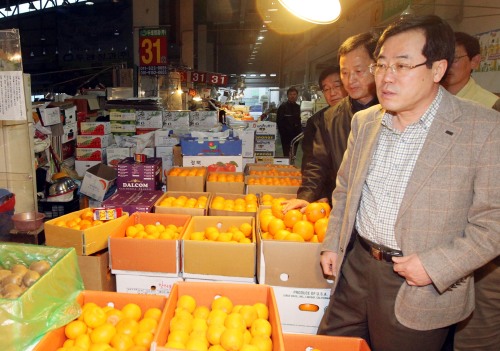
Government officials visit a local market to check food prices. (Yonhap News)
South Korea's consumer prices grew at the fastest pace in 29 months in March, putting a crimp in the government's efforts to tame soaring inflation, a report showed Friday.
According to the report by Statistics Korea, the country's consumer price index jumped 4.7 percent last month from a year earlier, marking the fastest on-year hike since October 2008 when it rose 4.8 percent.
From the previous month, consumer prices rose 0.5 percent.
Excluding volatile oil and food costs, core inflation prices grew
3.3 percent from a year earlier, up from 3.1 percent tallied for February, the report showed.
The hikes were driven mostly by price increases in oil and agricultural products, which jumped 15.3 percent and 14.9 percent, respectively, from a year earlier, the report showed.
South Korea's consumer prices are closely watched as concerns over inflation are deepening among policymakers and experts fearing that fast price hikes could undercut the nation's economic growth momentum going forward.
Such concerns prompted the government to launch "all-out"
efforts to fight inflation earlier this year. It unveiled diverse measures such as easing import taxes on basic goods, unloading its stockpiles of agricultural products and cracking down on price-rigging in the corporate sector that it fears could lead to a rise in consumer prices.
But it appears to be losing ground in the battle in the face of uncontrollable external factors. Higher crude oil prices are a major cause of concern as they drive up prices of many of manufactured products here in Korea, which imports most of its energy needs.
The drawn-out political unrest in the Middle East and North Africa is clouding the outlook further as it will likely put more upward pressure on oil prices by disrupting the supply of energy, experts said.
South Korea's economy remains on a solid recovery track, and the government forecast that it will grow 5 percent this year with inflation to be stabilized at around 3 percent. However, experts express skepticism that it could be difficult to achieve both targets given the current situations at home and abroad.
Apparently taking heed of such concerns, the government recently shifted its policy priority from growth to price stability.
Last month, the Bank of Korea (BOK), the nation's central bank, joined the anti-inflation drive by raising its key interest rate by a quarter percentage point to 3 percent. That marked the fourth rate hike since July last year from a record low of 2 percent.
Experts expect that the BOK might raise the borrowing cost several more times this year in line with its stepped-up efforts to ease mounting inflationary pressure. The bank will hold a rate-setting meeting on April 12.
(Yonhap News)
<한글 기사>
물가 4%대 고공행진..29개월來 최고
3월 소비자물가 4.7% ↑..3개월째 4%대 고공행진
전세 3.7%↑ 석유류 15.3%↑..정부 "4월 이후 서서히 안정"
3월 소비자물가가 3개월 연속 4%대 고공 행진을 이어가며 글로벌 금융위기 이후 가장 높은 수준까지 치솟았다.
리비아와 바레인 사태 등 중동의 연이은 정세불안 소식에 따른 국제유가 급등으 로 석유류 가격은 15.3%나 상승했으며 전•월세 가격도 크게 올라 집세는 2003년 7 월 이후 최고치를 기록했다.
1일 통계청에 따르면 3월 소비자물가는 지난해 같은 달에 비해 4.7% 상승했다.
전월 대비로는 0.5% 올랐다. 전년 동월 대비 물가상승률은 글로벌 금융위기가 닥쳤던 2008년 10월(4.8%) 이래 29개월만에 최고치다.
소비자물가는 지난해 2월 2.7% 이후 8월까지 2%대를 유지하다가 그 해 9월 3.6% , 10월 4.1%, 11월 3.3%, 12월 3.5%로 불안한 모습을 보였다.
또 올해 들어서는 중동 정정불안에 따른 유가 상승, 이상한파, 구제역 사태까지 터지면서 1월 4.1%, 2월 4.5%로 높은 상승률을 보였다.
윤종원 기획재정부 경제정책국장은 "3월 소비자물가 상승률이 4% 후반이 될 것으로 예상했는데 예상 범위 안에서 수치가 나왔다"며 "정부는 4월 이후에는 물가상 승률이 서서히 떨어질 것으로 전망하고 있다"고 말했다.
식료품 등 생활물가지수는 작년 동월 대비 4.9% 올랐고 전월에 비해서는 0.4% 상승했다.
생선ㆍ채소ㆍ과실류 등 신선식품 지수는 지난해 같은 달에 비해 19%가 올라 작년 6월 이후 10개월 연속 두 자릿수 상승세를 보였다. 전달에 비해서는 0.6%가 하락 했다.
농산물ㆍ석유류를 제외한 근원물가는 작년 동월 대비 3.3% 올라 2009년 8월(3.1
%) 이후 최고를 기록했다. 근원물가 상승률은 전월에 비해서도 0.3% 올랐다.
부문별로 작년 동월 대비 증가 폭을 살펴보면 농산물(17.4%)과 축산물(11.6%), 수산물(10.5%)의 가격이 크게 올라 농축수산물이 14.9% 올랐고, 공업제품도 석유류( 15.3%)의 가파른 상승세에 따라 5.9% 상승했다.
서비스 부문은 2.5% 상승한 가운데 집세가 3.2%, 개인서비스 3.0%, 공공서비스가 0.6%의 상승률을 보였다.
소비자 물가 기여도(작년 동월비)는 공업제품이 1.84%포인트로 가장 높았고, 서비스 1.47%포인트, 농축수산물 1.32%포인트였다.
작년 동월 대비 품목별 물가 상승률은 농축수산물 중에서 마늘(78%), 파(63.6%), 배추(34%), 돼지고기(31.7%) 등의 상승률이 높았다. 반면 국산 쇠고기(-9.2%), 오이(-22.4%), 풋고추(-22.5%) 등은 가격이 하락했다.
공업제품 중에서는 국제 금값 급등에 따라 금반지가 25.2% 올랐고, 국제 유가 급등의 영향으로 등유(24.9%), 경유(18.9%), 휘발유(13.8%)도 높은 상승세를 보였다.
윤종원 국장은 "고유가 상황이 상당기간 지속될 것으로 전망돼 기름값이 하락하는 속도는 더딜 것으로 보인다"며 "대외불안 요인 등 물가에 영향을 미치는 요인들을 철저히 모니터링하고 있다"고 말했다.
정부의 두 차례에 걸친 전ㆍ월세 안정 대책에도 전ㆍ월세 가격도 급등했다.
전세(3.7%)는 2003년 9월(3.9%) 이후 최고의 상승률을 기록했고, 월세(2.1%)도 2002년 5월(2.2%) 이후 최고치를 보였다. 전ㆍ월세 등을 포괄한 집세(3.2%)는 2003년 7월(3.3%) 이래 최고치를 기록했다.
개인 서비스 중에서는 외식 삼겹살(12.8%), 외식 돼지갈비(11.9%), 미용료(7.1%) 등의 상승률이 높았다. 학교 급식비는 21.3% 하락했다.
(연합뉴스)






